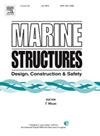A CPT-based p-y model for laterally loaded monopiles in sand
IF 4
2区 工程技术
Q1 ENGINEERING, CIVIL
引用次数: 0
Abstract
Large-diameter monopiles are currently the dominant foundation solution for supporting offshore wind turbines (OWTs). Monopiles exhibit a rigid response with significant rotation under lateral load and overturning moment. There is some debate regarding the applicability of p-y models derived from tests on small-diameter slender piles (such as the sand p-y model recommended by the API standard) to monopiles. To address this issue, this study gathered existing field pile load tests and finite element analysis results for large-diameter monopiles in sand and established a database incorporating the CPT results from each testing site. Through a comprehensive analysis of the collected database, a CPT-based p-y model with a modified hyperbolic formulation is proposed. The model has four parameters, which are the initial soil-pile interaction stiffness (kini), the ultimate soil resistance (pu), the stiffness degradation coefficient (m), and the ultimate soil resistance adjustment coefficient (A). All of them are functions of the CPT cone tip resistance (qc), thus avoiding potential uncertainties with the determination of input soil parameters, such as the peak friction angle, which is necessary for the conventional API p-y model. The model is demonstrated to provide satisfactory performance in predicting the lateral response of monopiles in sand.
砂中单桩横向加载的基于cpt的p-y模型
目前,大直径单桩是支撑海上风力发电机组的主要基础方案。单桩在侧向荷载和倾覆力矩作用下具有明显的刚性响应。关于从小直径细长桩试验中得出的p-y模型(如API标准推荐的砂p-y模型)对单桩的适用性存在一些争论。为了解决这一问题,本研究收集了已有的砂土中大直径单桩的现场荷载试验和有限元分析结果,并建立了一个包含每个试验点CPT结果的数据库。通过对收集到的数据库的综合分析,提出了一个基于cpt的p-y模型,该模型具有改进的双曲公式。该模型有4个参数,分别是初始土桩相互作用刚度(kini)、极限土阻力(pu)、刚度退化系数(m)和极限土阻力调整系数(A),它们都是CPT锥尖阻力(qc)的函数,从而避免了输入土参数(如峰值摩擦角)确定时可能存在的不确定性,而传统API p-y模型则需要这种不确定性。该模型在预测砂土中单桩的侧向响应方面具有较好的效果。
本文章由计算机程序翻译,如有差异,请以英文原文为准。
求助全文
约1分钟内获得全文
求助全文
来源期刊

Marine Structures
工程技术-工程:海洋
CiteScore
8.70
自引率
7.70%
发文量
157
审稿时长
6.4 months
期刊介绍:
This journal aims to provide a medium for presentation and discussion of the latest developments in research, design, fabrication and in-service experience relating to marine structures, i.e., all structures of steel, concrete, light alloy or composite construction having an interface with the sea, including ships, fixed and mobile offshore platforms, submarine and submersibles, pipelines, subsea systems for shallow and deep ocean operations and coastal structures such as piers.
 求助内容:
求助内容: 应助结果提醒方式:
应助结果提醒方式:


